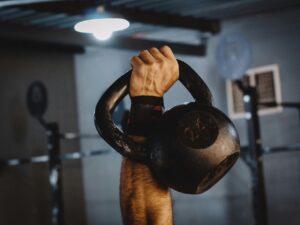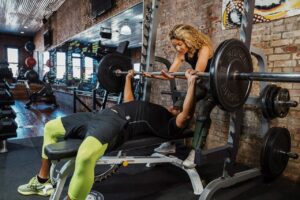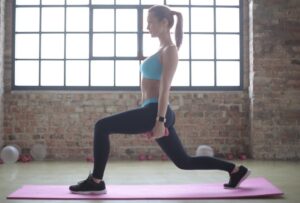The bicep is a two-headed muscle that makes up the front portion of the upper arms. Its primary functions are elbow flexion (bending of the arm) and wrist supination (rotating your wrist out so your palm faces forward or up) (1).
As its name suggests, the bicep is a two-headed muscle consisting of a short inner and long outer head that run parallel and work together (1).
The brachialis is a large muscle situated underneath the bicep. It assists the bicep during elbow flexion and developing it pushes the bicep up, contributing to a more prominent peak (2).
Despite its simplicity, the bicep responds well to various compound and isolation exercises.
Let’s explore the two types of movements and 15 great exercises to consider.
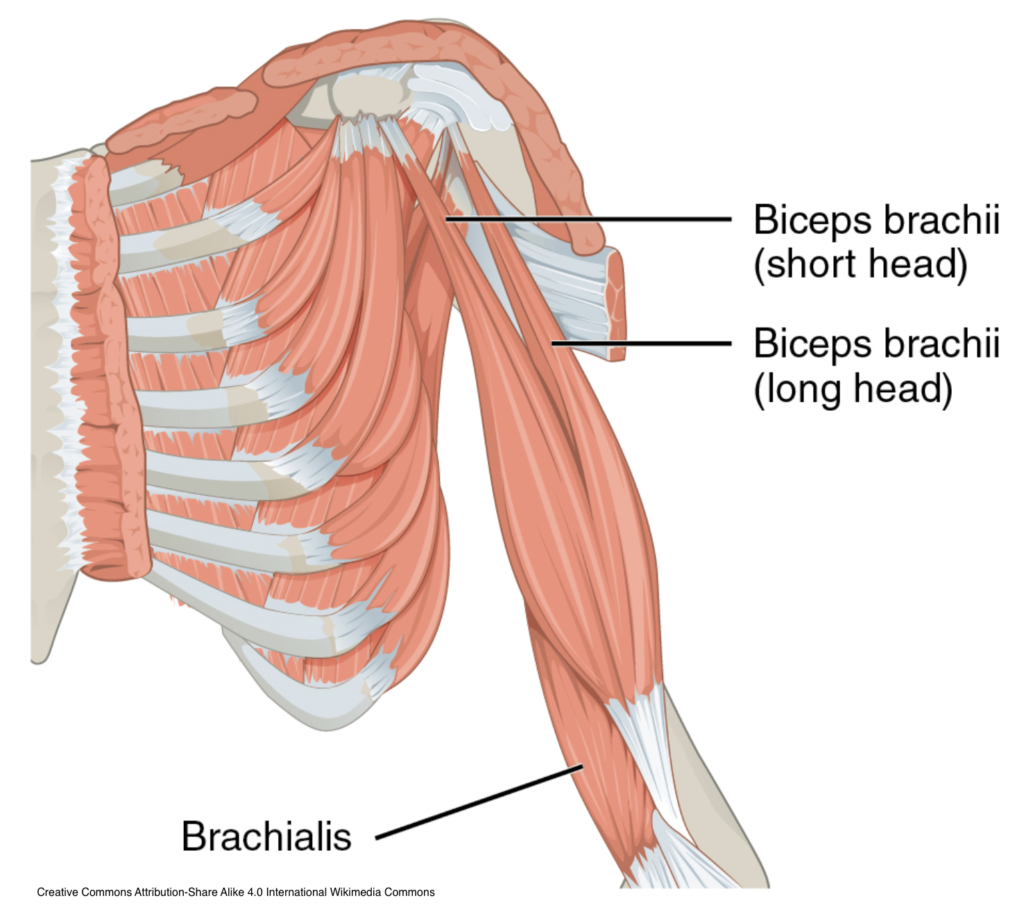
Isolation and Compound Exercises Biceps
Compound exercises are multi-joint activities that target multiple muscle groups and involve two or more joints.
A typical example would be the chin-up, where the objective is to grab a horizontal bar with an underhand grip (palms facing back) and pull yourself up. The movement involves several back muscles (latissimus dorsi, trapezius, rhomboids, etc.), the shoulders, midsection, forearms, and biceps (3).
In contrast, isolation movements are single-joint exercises that develop one muscle group and involve one joint.
An example would be the standard dumbbell bicep curl. The objective is to grab a dumbbell and lift it by bending your elbow. The only involved joint is the elbow, and your bicep does almost all of the work.
When to Do Compound or Isolation Exercises
Compound exercises should take priority over isolation movements and make up the bulk of your training. There are two primary reasons why:
- Multi-joint activities allow you to overload your muscles and provide the mechanical tension necessary for hypertrophy and strength gains (4).
- Compound exercises are more challenging to perform, and the risk of technique breakdown is higher. Doing these activities early while you’re still fresh allows you to perform at your best and do more quality repetitions.
In contrast, isolation movements exist to provide a more targeted stimulus to specific muscle groups, which is necessary for optimal muscle gain, the prevention of muscle imbalances, and such.
You can finish your workouts with isolation exercises because they are easier to do, and the risk of poor technique is small, even if you’re tired and eager to go home.
As you’ll see in the following points, most compound activities that involve the biceps do so in a secondary matter. In other words, other muscles do the majority of the work, and the biceps serve to assist.
Examples of such activities include back exercises: pull-ups, bent-over rows, lat pulldowns, etc. The lats, rhomboids, and other back muscles produce most of the force, and the biceps assist with elbow flexion.
In contrast, bicep isolation exercises don’t generally involve other muscles, and you can do them in almost any order you prefer.
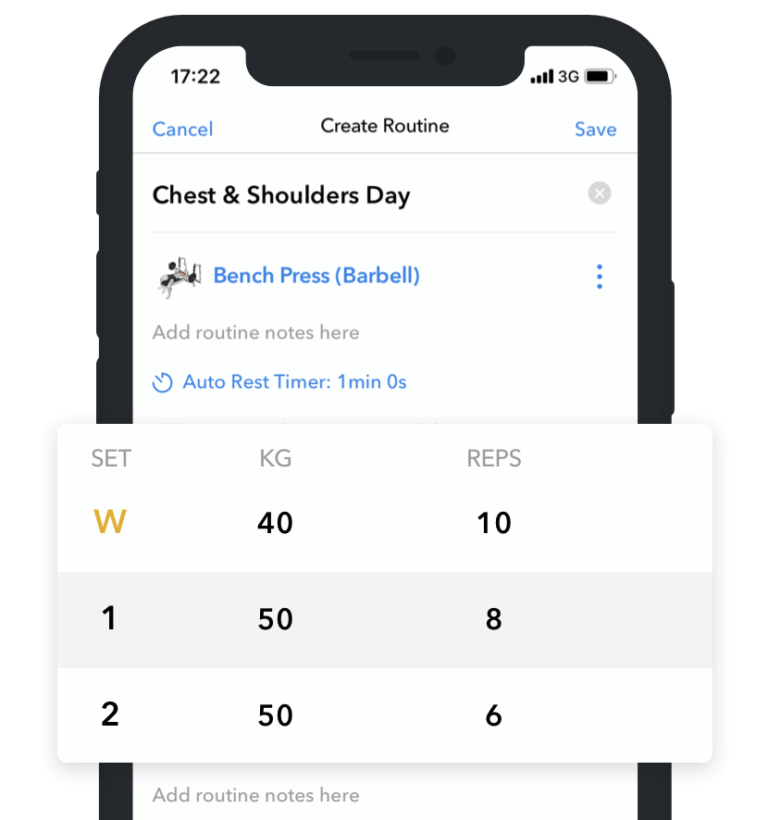
Hevy – Workout Tracker





Hevy – Workout Tracker
Create your bicep workout with Hevy, and track your progress
Deciding when to do compound and isolation movements for your biceps mostly depends on the type of training split you’re doing. Let’s look at two scenarios and track your progress with the Hevy app:
Scenario 1: Push/Pull/Legs
You train your back and biceps together during a push/pull/legs split. It’s best to start with compound movements that train your back and finish your sessions with isolation movements for your biceps.
For example:
Pull Up – 4 sets
Bent Over Row (Barbell) – 4 sets
Lat Pulldown (Cable) – 3 sets
Seated Cable Row – 3 sets
Bicep Curl (Barbell) – 3 sets
Hammer Curl (Dumbbell) – 3 sets
In the first scenario, your biceps receive plenty of stimulation from the compound exercises, and you finish them off with isolation activities.
Related article: Back and Bicep Workouts for Building Strength
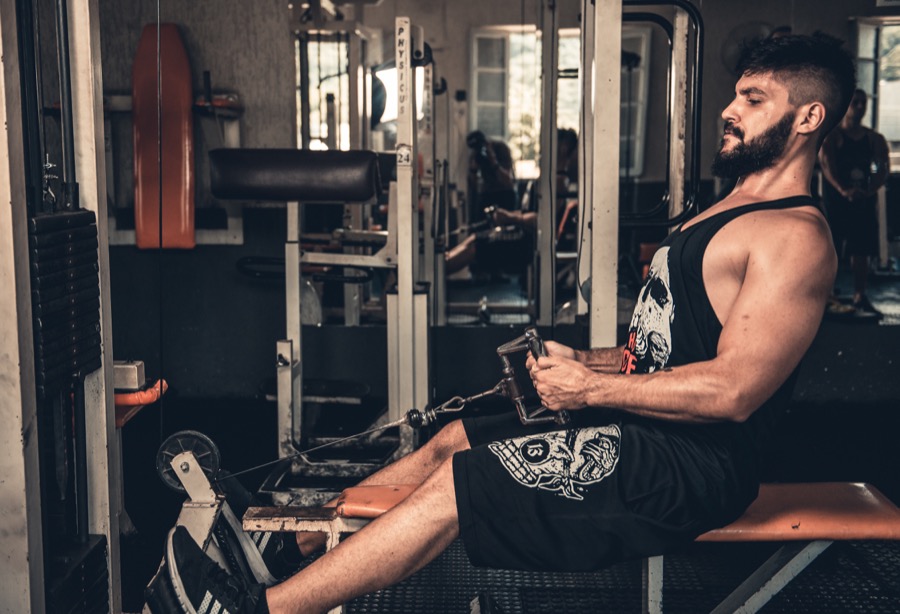

Scenario 2: Bro Split
Depending on how you schedule a bro split, you can have an entire day dedicated to training arms: biceps, triceps, and forearms. It mostly comes down to sequencing exercises based on difficulty in such a case.
For example, you want to do barbell, machine, and concentration curls.
A good order would be the following:
- Bicep Curl (Barbell)
- Bicep Curl (Machine)
- Concentration Curl
That specific order would allow you to train in various repetition ranges to provide a more balanced stimulus to your biceps. Barbell curls are well suited for heavier weights, whereas it is better to use moderate and light loads on the remaining two.
For example, you can do heavier sets on barbell curls (6 to 10 reps), moderately-heavy sets on machine curls (10 to 12 reps), and finish off with light sets for metabolic stress on concentration curls (15+ reps) (4).
7 Compound Bicep Exercises
1. Bodyweight Curls
Bodyweight curls are an equipment-free exercise you can do to strengthen and develop your biceps.
Instead of raising an external weight (e.g., a barbell or pair of dumbbells), you lift your body through elbow flexion.
One of the most practical ways to do bodyweight curls is to grab a horizontal bar, lean your body back, and repeatedly flex your elbows to train your biceps.
2. Chin Up/Pull Up
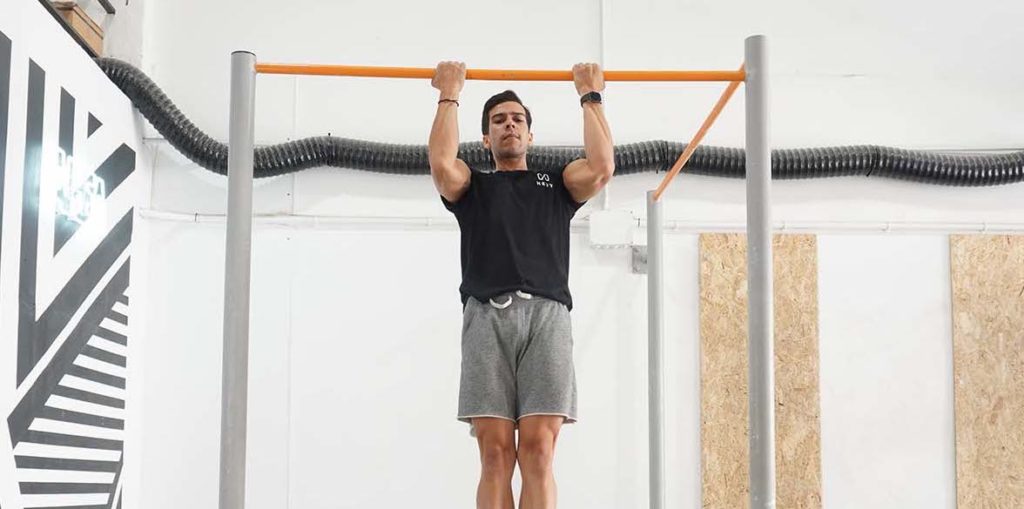

Chin-ups and pull-ups are compound exercises that target the back.
The primary difference between the two movements is that you use an overhand grip (palms facing forward) during pull-ups and an underhand grip (palms facing back) during chin-ups.
Both versions lead to bicep activation, but chin-ups give the muscle a mechanical advantage, allowing it to contribute more. As such, chin-ups are one of the best bicep compound exercises.
3. Bent Over Row (Barbell)
Bent-over barbell rows are an effective exercise that overloads all the major back muscles and works the biceps.
The two primary ways to do the exercise are with an overhand (palms facing back) or underhand grip (palms facing forward).
An underhand grip allows you to target your biceps more effectively and create enough mechanical tension for hypertrophy and strength gain (4).
4. T Bar Row
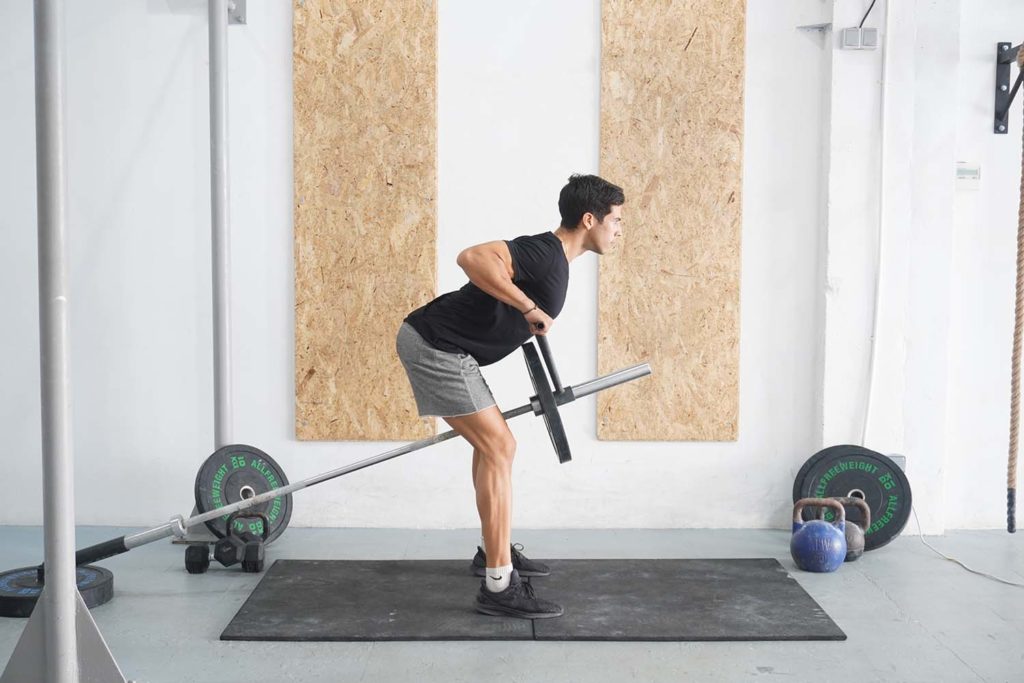

T-bar rows are identical to the bent-over row. The primary difference is that you’re using a T-bar station or anchoring a barbell to a landmine attachment.
You can use various grip types depending on your setup. Having your palms facing forward forces your biceps to contribute to a greater extent, contributing to their development.
In contrast, a neutral grip or one where your palms point back is better for the back and forearms.
5. Inverted Row
Inverted rows are an effective bodyweight exercise that strengthens the back, midsection, shoulders, and arms (5).
The objective is to grab a horizontal bar, straighten your body, and plant your feet. Once in position, repeatedly pull yourself, touching the bar with your chest or upper stomach.
Like many other bodyweight exercises, subtle tweaks in technique can increase or decrease the difficulty. For example, the more upright you are, the easier it is to pull yourself. In contrast, becoming more horizontal makes the exercise more challenging.
An underhand grip (palms facing back) can lead to better activation of the biceps.
6. Dumbbell Row
The dumbbell row is a compound back and bicep exercise that offers two unique benefits.
First, both sides work independently, which is beneficial for balanced development.
Second, dumbbells allow for a slightly longer range of motion, contributing to stronger bicep contractions.
You can train one side at a time or grab a pair of dumbbells, lean forward, and row, similar to a bent-over barbell row.
7. Lat Pulldown (Cable)


Cable lat pulldowns are one of the more straightforward and beginner-friendly compound exercises for the back and biceps (6).
The objective is to grab a lat pulldown bar (or another attachment), set yourself on a pulldown machine, and repeatedly pull the bar to your chest, mimicking the motion of a pull-up.
Your two primary options for doing lat pulldowns are using an overhand or underhand grip. Make lat pulldowns more bicep-dominant by having your palms facing back, like a chin-up.
A notable benefit of pulldowns is that you can adjust the resistance to fit your strength level.
8 Bicep Isolation Exercises
1. Bicep Curl (Barbell)
Barbell bicep curls are one of the best isolation bicep exercises that allows you to overload the muscle and develop both heads.
A wider grip emphasizes the inner portion of the bicep, whereas a narrower grip develops the outer head, contributing to the bicep peak.
Barbell curls are one of the few bicep isolation exercises that allow you to go heavy (6 to 8 reps) and maintain proper technique.
Related article: 15 Best Long Head Bicep Exercises to Get Bigger Arms
2. Bicep Curl (Dumbbell)
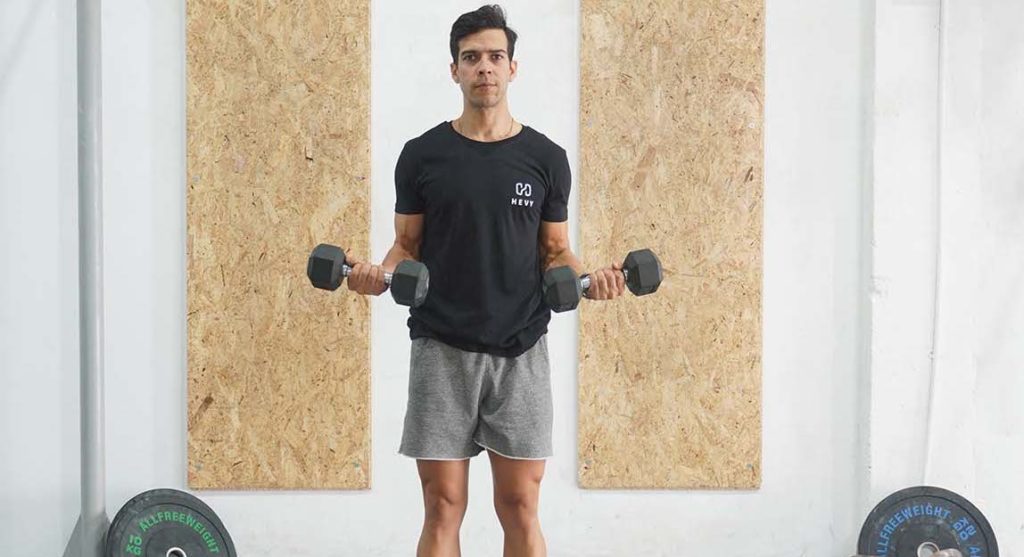

Dumbbell curls are another popular bicep isolation exercise that offers unique benefits.
A notable advantage is that you can do several versions of the movement:
- Standing
- Seated
- With wrist rotation
- Without wrist rotation
Doing curls from a seated position reduces the use of momentum and can improve bicep activation.
As for wrist rotation, you can do either version. No wrist rotation means your palms face forward from start to finish. In contrast, using wrist rotation means your palms face your body at the bottom, and you gradually rotate them out to point up at the top.
3. Concentration Curl
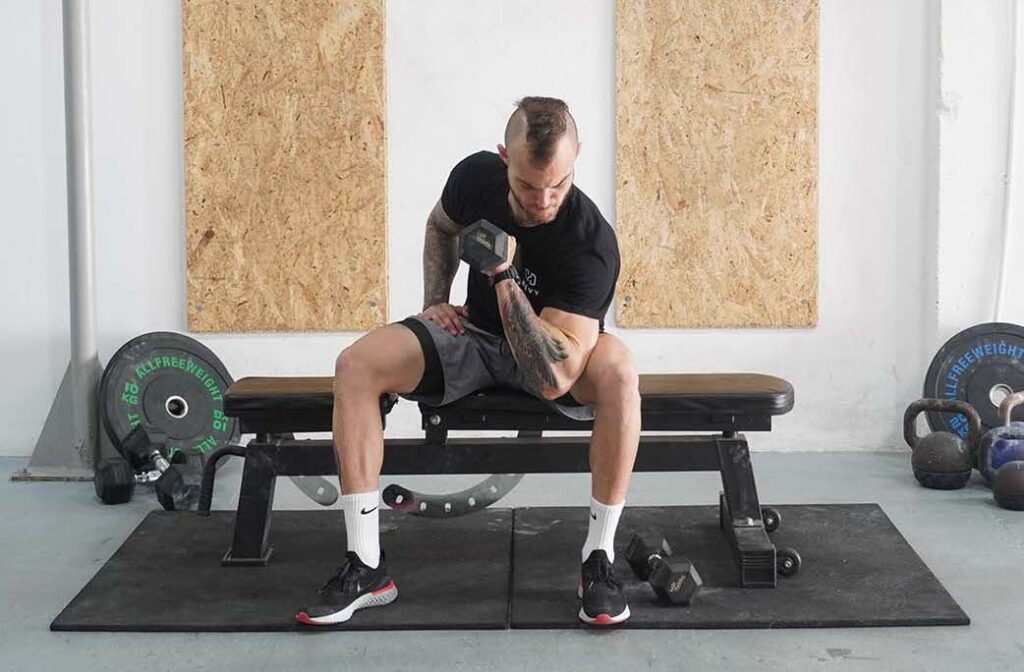

Concentration curls are another useful bicep isolation exercise where the risk of technique breakdown is small.
The objective is to sit down, spread your legs wide, and position the rear of your upper arm against the inner thigh for support. From there, curl a dumbbell or kettlebell as many times as possible.
Assuming such a position reduces the risk of using momentum or swinging your elbows back and forth to do more reps or lift a heavier weight. Instead, your biceps must do all of the work.
Related article: 10 Short Head Bicep Exercises for Thick Upper Arms
4. Drag Curl
Drag curls are a less common bicep isolation exercise. The objective is to curl a weight (e.g., straight bar or dumbbells) but keep it close to your body from start to finish. Doing so requires bringing your elbows back as you bend your arms.
One benefit of drag curls is they can improve bicep activation, particularly at the top. Plus, dragging the weight against your body reduces the risk of using momentum.
5. Hammer Curl (Dumbbell)
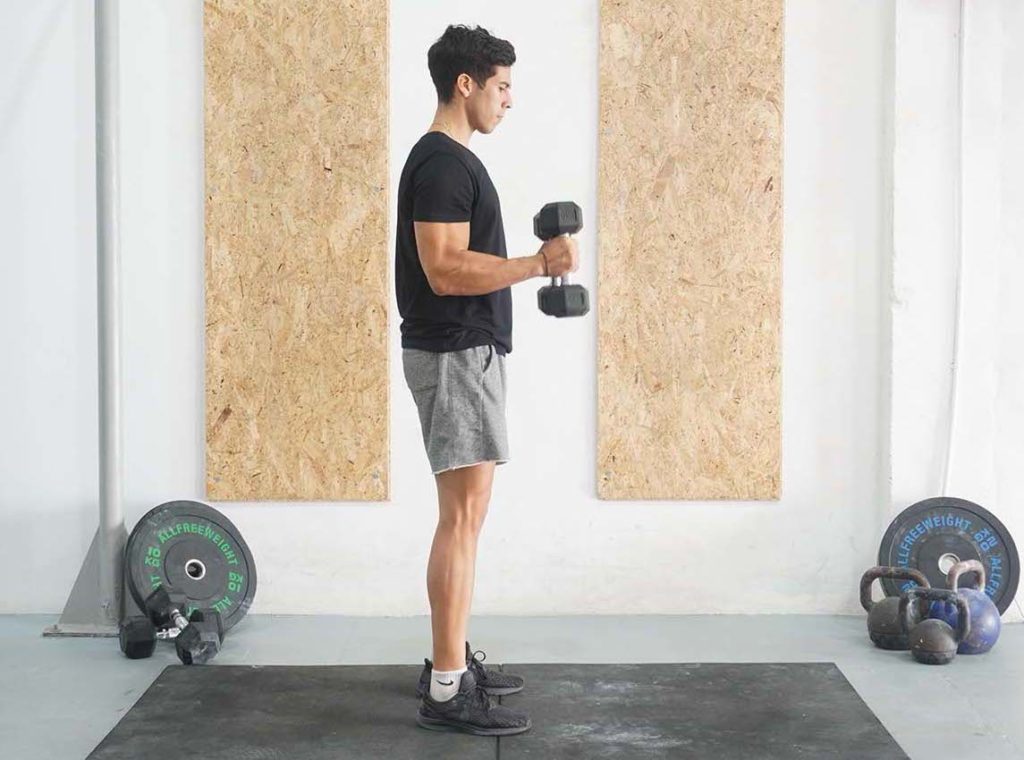

Hammer curls are another popular bicep isolation exercise with unique benefits.
The objective is to curl a pair of dumbbells but keep your wrists in a neutral position (facing one another) from start to finish. Doing so allows you to use more weight and activates your forearms alongside the biceps and brachialis.
You can perform these standing or seated, depending on preference.
6. Plate Curl
Plate curls are a practical and straightforward bicep isolation movement. The objective is to grab a weight plate by its sides, position it in front of your body, and curl.
You can do these with a heavier plate for fewer reps, or pick a lighter weight plate and do 15, 20, or even 30 reps per set.
Plate curls are fantastic for finishing off your biceps at the end of your session. For example, once you’re done, pick up a light plate and do as many reps as possible.





Hevy – Workout Tracker





Hevy – Workout Tracker
Create your bicep workout with Hevy, and track your progress
7. Preacher Curl (Dumbbell)
Despite their position on our list, dumbbell preacher curls are one of the best bicep isolation exercises.
The objective is to position yourself on a preacher bench, grab a dumbbell, and place the back of your upper arm against the pad. Once in position, lift the weight as many times as possible.
Like concentration curls, keeping your elbow against the pad prevents you from using momentum and forces your bicep to do all the work.
Related article: Beginner & Advanced Kettlebell Arm Workout (+10 Exercises)
8. Rope Cable Curl
The rope cable curl is a unique bicep exercise. Unlike traditional free-weight curls, using a cable machine provides consistent tension, which can lead to better bicep activation.
Like other curls, you can overload your biceps with more weight or do high-rep sets for metabolic stress (4).
Aside from using a rope, you can attach a handle to the pulley and train your arms one at a time.
Final Words
There are plenty of compound and isolation bicep exercises to include in your workouts.
Multi-joint movements like the bent-over row emphasize other muscles but stimulate the biceps and promote strength gain.
In contrast, bicep isolation exercises like concentration curls are excellent for wrapping up your training sessions and focusing entirely on the biceps.
Doing both types of activities is crucial for optimal strength and muscle gain.
Other articles from the series:
- The Top 7 Isolation And 7 Compound Ab Exercises
- 10 Compound and 4 Isolation Back Exercises for an Impressive V-Taper
- 8 Compound and 6 Isolation Chest Exercises for Strong Pecs
- 5 Isolation and 9 Glute Compound Exercises for a Head-Turning Behind
- 7 Isolation and 8 Compound Leg Exercises for a Strong Lower Body
- 8 Isolation and 9 Compound Shoulder Exercises
- 7 Isolation and 7 Compound Tricep Exercises For Big Arms


